Sand rivers (22 page)

For all one reads about lion and elephant, buffalo and rhinoceros, it is probably this vast water pig of other ages, with its immense jaws and long shearing teeth and unexpected speed, that kills more people than any other animal in Africa, and it does so most often when, as now, it finds itself cut off from sanctuary in the water. We stand a moment, at a loss, listening to this beast's companions disporting in the river, and then Goa leads in a polite circling maneuver, working inland to give the hippo a clear path. Misinterpreting this move, the hippo retreats inland a little, too, then stops to glare again, coming fully about to face us as it does so. Because we are all hot and tired, and no solution is in sight, we cross quickly between the hippo and the river as Goa calls to the young porters to keep up.
In the dense river thickets once again, the porters keep up smartly without being told. Brian kicks at fresh manure and mutters, "Liable to turn up a buffalo just now ..." He has scarcely spoken when the porters yell and scatter, dropping their loads. Goa whirls and raises the rifle; we had passed the buffalo, which then burst from a thicket by the river only a
SAND RIVERS
few yards from the line of men. It does not charge but runs off in the direction we have come, as all the porters squeal with nervous laughter.
Never having been on safari before the young porters are inexperienced with big animals, but this has not always been true of the Ngindo. Though they practice a subsistence agriculture - growing mostly maize, millet, and cassava - and keep a few goats and chickens, the Ngindo were essentially hunter-gatherers until this century and to this day have retained the small, slight stature of bush hunters. Probably they made small impact on the wildlife populations, since apparently they were always few in number, living in small, semi-nomadic groups along the rivers. A Portuguese document of 1616 mentions the sparsity of the inland population in this region, referring to it as a "terra deserta", and human numbers were maintained at a low level by the constant attrition of the Arab slavers, the Ngoni Zulu, and the Germans. Though some Ngindo must have been taken as porters and slaves, they offered no resistance to the caravans of the eighteenth and nineteenth centuries that passed through on the way to the interior from Kilwa; where chance offered, in fact, they stole one another's children and bartered them for salt, cloth, and the primitive firearms that^till serve in out-of-the-way places as items of prestige, and thus made at least a minor contribution to the desolation and disruption of the countryside, the pillage and burning and inter-tribal raiding, and the destruction of wildlife that the slavers and ivory-traders left in their wake almost everywhere throughout the country.
Though local tradition says that the Ngindo people were always forest hunters, it may be that this was a consequence of chronic disruption and flight. "We do not stay long enough to eat our own mangoes", is an Ngindo proverb. The original Ngindo homeland is thought to have been further south, extending across the Ruvumu River into what is now Mozambique; apparently they were pushed northward by the Ngoni Zulu who swept up from southern Africa in the nineteenth century. Eventually the fierce Ngoni, with their well-organized militia, came into bitter conflict with the Germans who were settling this region from the north, and the hapless Ngindo were caught in between. Having gone to the Germans for protection against the Ngoni, they found that these white men were still worse. Wanatoka wafako, wanakwenda waziwako, they said, in mourning for themselves: They go from where there is death to where there is burial.^ The Germans needed slave labor to make cash crops out of their cotton, and malingerers were given twenty lashes. These beatings inspired such resentment that finally, in 1905, the Ngindo people at Kabata, not far east of the Selous Reserve boundary, rebelled against an order to pick cotton. The revolt spread to the Lung'onya River region, where a witch doctor produced a magic water to protect Africans from European bullets, and soon five Germans, including a bishop and a nun, were destroyed by Ngindo at a place called
PETER MATTHIESSEN
Mukukuyumbu, near Liwale; others were killed by Pogoro people near Madaba, and it was at Madaba that there commenced, in November of that year, the efficient and thorough suppression of what came to be known as the Maji-Maji Rebellion. The Germans are said to have made a point of executing the eldest son of every family in the region, and at least 100,000 Africans were slaughtered. (In this same period, the Germans were carrying out repressions of a comparable brutality among the Herero of what is now Namibia.) Everywhere villages and crops were put to the torch, with no respite for the planting of new gardens, and in the next three years as many thousands - hundreds of thousands, some authorities have said - died of starvation, the humid skies were dark with vultures and a shroud of fire, and lions prospered. In 1908, an old man named Sulila at Masasi made a song recounting the dark yearsof his people:
Then comes the war of the Mazitu [Ngoni]; guns are fired by the Germans; then they ran away. But the Germans came; it was dangerous to see. The bush was burnt; the goats were burnt; the fowls were burnt - the people were finished altogether. The tax came up . . . still they were not satisfied. Mr. Sulila telegraphed to the District Commissioner, "He may skin me to make a bag for his money. Now I am tired. "^
An historian wrote, in a paraphrase of Tacitus, "The Germans in East Africa made solitude, and called it peace."'*
Just after five, we make camp beneath a big tamarind at the river's edge, opposite a grove of high borassus. Upstream, a solitary bull elephant wanders the bank; further on an eland emerges from the trees, very pale against the dark greens of the river forest, and a cow elephant and calf stand at rest in the late afternoon sun, as if lost in some long twilight meditation. A harsh racketing downriver is made by a pair of huge Goliath herons, perfoming a courtship ritual in the shallow water: it seems appropriate that the largest members of their worldwide families, the Goliath heron and the giant kingfisher, are still abundant on these big wild rivers, though no longer common elsewhere in East Africa. The herons display to each other with broad wings and nervous dancing as a third heron, to all appearances an injured party, turns its back on them and sits in a hunched position on a sand bar, staring toward the north.
Kazungu brings us mushroom soup, and Brian gives his bowl to me; he cannot eat it. In 1959, he says, he came down with serious stomach pains, which he did nothing about for four years. "Had knotted guts whenever 1 ate anything; couldn't eat fresh fruit or vegetables at all. Finally got down to about one hundred pounds." Not until it seemed that he might starve to death was he persuaded to go to the tropical disease
SAND RIVERS
hospital in London, where his ailment was eventually diagnosed as Histoplasma Duboisiei, the first recorded case in Africa of a rare gut fungus that is not uncommon in the Persian Gulf. "All they had were some experimental drugs, which they did not hesitate to recommend since otherwise 1 would be dead within six months. And the drugs worked, because here I am, but I really couldn't eat properly until 1973, when a friend of ours up in Nairobi recommended yogurt. Cleared me right up in two weeks - the only thing I can't eat now is mushrooms."
In fact Brian still eats very little, and seems to prefer the gray oatmeal gruel and rice that tided him over his long illness. Not being the sort to concern himself about other people's preferences, he discarded almost everything with taste in it that Karen Ross had set aside for our safari, saying that we must travel light. ("I tried to slip in a few goodies for you," Karen warned me, "but he tossed them right out again.") Brian sees no reason why I should not adjust my habits to having two meals a day. "People worry too much about food," he says. "Afraid of going without, so they eat too much, women especially - their main occupation, I suppose. Especially here in the tropics, where habits are apt to be sedentary, it is better to eat less." And so the single bowl of gray porhgi at mid-morning represents the midday meal as well as breakfast, and the rice with beans at supper is the one full meal of the day. I don't bother to protest that his bloody tent weighs a lot more than the discarded food: two meals suit me in this heat, and eaten outside under the trees and stars, the simple fare tastes very good indeed.
I ask Brian what the tropical disease hospital said about the yogurt cure for Histoplasma Duboisiei, and he says that he did not bother to report it. Taken aback, I ask - not entirely insincerely - if he does not wish to help his fellow man. "Not really," he said, not entirely insincere himself, and again I hear that echo of lonides: "The convenience or profit of others is a matter of supreme indifference to me unless it happens to coincide with my own."
In our camp tonight, Kazungu writes:
In the morning I made tea while other people packed up the camp - a tent for the two white people and a ground sheet for the rest of us. Then we began our safari. As usual we take our breakfast after two hours. We came across six elephant with calf and had to pass far away; as usual, an animal with baby is very fierce. We saw four buffalo, which are bad animals; he doesn't care about anything or anybody, but does what he likes, you cannot trust him. I fear the buffalo more than anyone . ..
We made a big fire because of wild animals like elephants and hippo so they would not come near. Most of riverside is path of wild animals to come and drink water. I didn't get good sleep because I have never slept outside without a tent.
PETER MATTHIESSEN
It is always Goa who puts up the tent, assisted by one of the young Ngindo, and it bothers me sHghtly every time they do it, probably because the Africans do not have one. It is true, of course, that they could erect the canvas kitchen fly brought for that purpose, but they prefer to use this as a ground cover, sleeping in a tight row on top of it and keeping the fire going all night long. They are uneasy about elephants as well as lions, but elephants rarely wander into camp except in parks. As Brian says, "The elephant is very considerate, really. Rhinos blunder in sometimes, and lions come about, but a round from the shotgun usually sees them off. Now a man-eater, of course ..."
In the distance rises the early morning sound of the ground hornbill, the remote dim hooting of a woodland spirit - poo-too, po-to - a lugubrious ghostly reverberation that seems to emanate from a cavern under the earth. In West Africa this bird is considered sacred, and Kazungu and Goa say that if you kill one, the young ones will appear by your house and make this sound -poo-too, po-to - and very soon you will take sick and die. The Ngindo say that Kazungu and Goa are mistaken: if you should be foolish enough to kill the nditi, as the bird is called in this part of Tanzania, you will die without further ado.
We make good time over the river plains - we are now well south of the black rock escarpments - passing large tame herds of wildebeest and impala, slowing only to make our way around the many elephants, not less than six groups in the first few miles, although there are never more than five together. None seem bothered by the file of men, there is no threat display whatever, and most of them do not move away as we go past. Buffalo sign is copious, but the buffalo remain hidden, as do the rhinoceros and the lion: last night I heard a lion roar toward dawn -1 have heard lion almost every night since coming to the Selous - but in this long-grass country they remain unseen.
A wood of "silver trees" (Termmalia sehcea), as Selous called them in his journals, descends to broad pans of black cotton clay twisted up into hard ruts and potholes by huge megafaunal feet - a quagmire during the rains, now petrified into near-stone that is very hard on the bare feet of the porters. Then we are in river forest once again, and here Goa slows a little, feeling his way into the gloom with hand held out in front like a moth's antennae, leading the file in a winding course to avoid a confrontation with the depositors of all this fresh and shining dung. In pockets of sun, I find myself alert to the white butterflies, cat musk, thick blood-red kigelia blossoms with long yellow stamens, and the somber hum of bees.
In mid-morning we come to an area that has been burned over. The fire is recent; there are no sprouts of green tussock, only white remnants
(Right) Departure on the foot safari. \144\
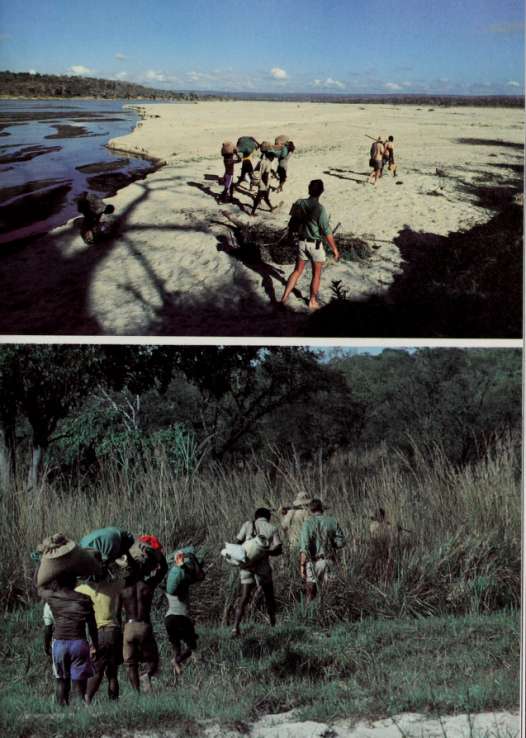
fe^-V •:,"■■
\
*

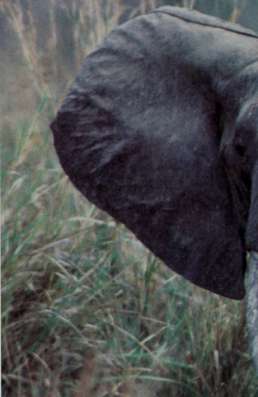
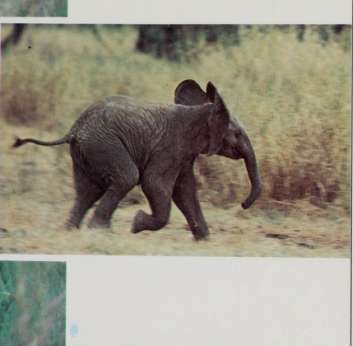
1
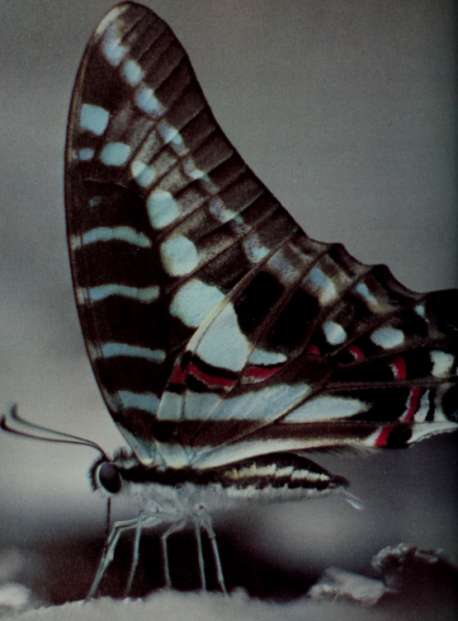
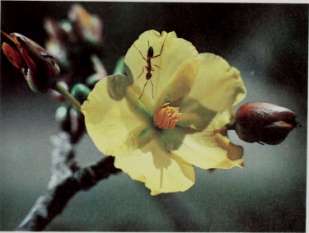
(Over) Little bee-eaters.
•4-;'v-^--'.
%
' i-: ^-^-r.
f>'^..
9- ■
'^^
im^
SAND RIVERS
on the blackened ground - the bone-white shells of millipedes and giant land snails unable to escape the sweep of fire. Antelope droppings are baked a strange bluish gray. Goa locates a simple cooking fire in the thicket on a mound, and we find the place, scraped bare of stones, where men have slept - the first and last sign of man's presence that we would come across in this country south of Mkangira.
After a silence Brian says, "Looks like they were here about a week ago." Perhaps he, too, is thinking that the animals seem very tame for a country in which poachers have been operating, for now he says, "It's possible, of course, that it's tambika - that's ancestor worship, from the days when people lived along these rivers. They come out here sometimes to tambika, or at least they did. On the other hand, poachers will use that as an excuse: 'We're just a few ancestor-worshippers who stumbled upon all this ivory we're carrying.'"
Over mid-morning porrigi and tea, Brian talks about the footpath that crossed the Selous Reserve between Liwale and Mahenge, beyond the western boundary. The Ngindo of Liwale have relatives at Mahenge who were cut off when lonides's expanding elephant reserve was joined to the original Selous, and to visit them without trespassing in the Reserve meant a journey on foot and by jitney of at least eight hundred miles. Since even those who could afford the time could not afford so many jitney buses, it was inevitable that people would cross illegally, and rather than have them scattered through the bush and perhaps remaining there, lonides had made it legal to use this footpath, which was about 120 miles in length. In Brian's opinion, this path a few miles to the south was probably the access route for whoever had made that camp fire.
"When they come in this far," he said, "they're after ivory and rhino horn; they can get meat much closer to home, most of it legally, because the country here in southern Tanzania is still wild. This isn't Kenya. In most of Kenya, until recently at least, almost the only game that people could find in most areas outside the parks was a few small antelope. Of course the poachers will shoot game, too, to live on, the way we're doing ourselves on this safari, but that's not why they're here."
The Ngindo hunters are leaders in their villages, as is the case among Goa's people; they are "poachers" only to the white men, whose demand for rhino horn and ivory is what has put the animals in danger. "Often a village will have one great hunter," Brian relates. "The people chip in and buy him a rifle and arrange for his bearers and assistants; others may also buy a gun and have him do their legal killing for them. He's not somebody out of work, or outside the law in any way; invariably, he's a respected member of the community, with wives and children and shambas and all sorts of prestige, which he deserves, because he takes risks and he knows his business. That's why it's hard to get people to testify against him. When I sent a man like that to jail, 1 used to go and pick him out again in about six months and have him come work for me;
PETER MATTHIESSEN
he would always be capable, and would know his region of the bush in great detail.
"Of course, people coming in this far have the rivers to contend with. In the dry season, they can wade across if they want to risk the crocodiles, but in the old days, at least when there was patrolling, they came mostly in the rains, when they knew that the tracks would all be mired and our machines unable to move. In a river as large as this, they'd use a kungwa, which is essentially a section of muyombo bark about nine feet long, the half-round of a big tree or all of a small one split along one side, with ends plugged up with bark and mud. Pretty rickety affair, but it usually got them over. Up on the Kilombero, of course, the poachers coming in from outside would come down in canoes, especially when the crocodile trade was in full swing." Brian grinned a little to himself, remembering. "Once we were trekking up the Kilombero - we'd heard there was poaching up that way - and we saw that the poachers had their camp out on an island, and we had no boats. So we sent one of the game scouts up the river, pretending to be a poacher himself, and yelling across that a hippo had overturned one of his canoes and a man had drowned, and to please send help. When the canoes came from the island, we arrested the rescuers, then used the canoes to go back to the island and arrest the others, though not without a fight."
Until 1958, when Alan Rees became warden of the western Selous, the poaching there had been almost as rampant as it was in the north, near the towns and the main road; in fact, the Reserve was overrun by meat-hunters, often outfitted by local traders, and the slaughter of game was so widespread that certain regions have not fully recovered to this day. Not until 1961, when the Selous Reserve administration was coordinated under a new chief warden. Major B.G. Kinlock, was poaching brought under control in the north and west: between mid-1962 and the end of 1963 some 1600 people were convicted for offenses in the Game Reserve; many tons of wire snares and miles of fencing were seized and destroyed, and more than 200 firearms were confiscated, together with an enormous collection of spears and bows and arrows. From that time until Nicholson's own departure in 1973, organized poaching was no longer a problem in the Selous.
On the river beach at the next bend, where two hippos stand facing each other as if made of stone, a line of siafu, or soldier ants, is moving along a narrow tunnel just under the surface of the sand; the tunnel is roofed with a sand crust, but here and there the crust has fallen, exposing the glistening nerve of ants as they hasten away into the thicket.
"I remember the old days on the farm," Brian said. "We'd have to camp out when the ants came, because there were no insecticides or anything. But as soon as everything was eaten, they would go away, having cleaned the place out down to the last cockroach; wouldn't see a rat or a mouse for the next six months. There's nowhere to hide from